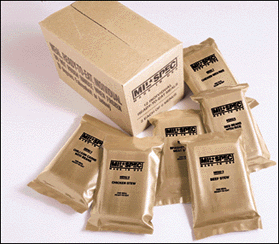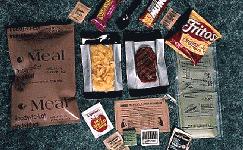
MRE Information |
|||||||||||||||||||||||
 |
 |
||||||||||||||||||||||
| fromwww.howstuffworks.com What's an MRE? MRE stands for "Meal, Ready-to-Eat." An MRE comes in a plastic pouch called retort packaging. The package is actually aluminum foil and plastic layered together. An MRE pouch contains normal food. It might contain chili or beef stew. The food is pre-cooked, put into the pouch and the pouch is sealed. The pouch and the food it contains are then heated for sterilization purposes. Since the pouch is sealed, the food stays fresh for a long time. This is no different from metal or glass canning -- the food in a can is sterilized by heat in a sealed container so bacteria cannot get in and spoil it. Think of retort packaging as a flexible can. The food tastes no different from canned chili or beef stew. Retort packaging is also used for a variety of drinks. Those drinks that come in a flexible pouch are usually made using the same technology used to create MREs. fromwww.beprepared.com Meals-Ready-to-Eat Originally designed for the U.S. government, these compact pouches contain delicious ready to eat foods. MRE's have been used sense the 1970's in the U.S. Space Program, Military, Forest Service and in more recent years, many foreign governments have started using these versatile foods. A main concern in the development and testing of rations for the U.S. government has always been shelf life. All MRE foods are packaged in triple-layer plastic/aluminum.plastic pouches that have better storage qualities than heavy cans, with no need for a can opener. The food in these pouches is precooked and sealed at a high temperature so that bacteria is neutralized and the food will be shelf stable even when stored at room temperature. Some of the best information available on MRE shelf life is the storage life chart (see below) compiled by the U.S. Army's Natick Research Laboratories. This chart provides a good overview and summary of the findings gathered from their testing of MRE Products.
More About MRE Shelf Life 1. The shelf life ratings shown in the chart on the front of this paper were determined by taste panels -panels of "average" people, mostly office personnel - at the Natick lab. Their opinions were combined to determine when a particular component, or in this case the entire MRE ration, was no longer acceptable. 2. The shelf life determinations were made solely on the basis of taste, as it was discovered that acceptable nutritional content and basic product safety would extend way beyond the point where taste degradation would occur. This means the MRE's would be safe and give a high degree of food value long after the timing suggested in the chart. 3. MRE pouches have been tested and redesigned where necessary according to standards much stricter than for commercial food. They must be able to stand up to abuse tests such as obstacle course traversal in field clothing pockets; storage outdoors anywhere in the world; shipping under extremely rough circumstances (such as by truck over rocky terrain); 100% survival of parachute drops; 75% survival from free failure drops; severe repetitive vibration (1 hour a t G vibration); 7,920 individual pouch drops from 20 inches; and individual ouches being subject to a static load of 200 pounds for three minutes. 4. Freezing an MRE retort pouch does not destroy the food inside, but repeated freezing increases the chance that the stretching and stressing of the pouch will cause a break on a layer of the laminated pouch. These pouches are made to withstand 1,000 flexes, but repetitive freezing does increase the failure rate by a small fraction of a percent. Also if MRE food is frozen, then thawed out, it must be used the same as if you had thawed commercial food from your own freezer at home. |
|||||||||||||||||||||||
Back to Bob Heffner's Pepperoni Roll Homepage